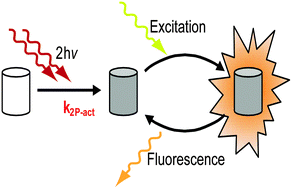Determination of two-photon photoactivation rates of fluorescent proteins
Abstract
The application of two-

- This article is part of the themed collection: Superresolution imaging and fabrication with light
* Corresponding authors
a Department of Cell Biology, Yale School of Medicine, New Haven, CT 06520, USA
b Department of Biophysical Chemistry, University of Heidelberg, 69120 Heidelberg, Germany
c Department of New Materials and Biosystems, Max Planck Institute for Metals Research, 70569 Stuttgart, Germany
d Department of Anatomy and Structural Biology and Gruss-Lipper Biophotonics Center, Albert Einstein College of Medicine, Bronx, NY 10461, USA
e Department of Genetics, Yale School of Medicine, New Haven, CT 06520, USA
f Department of Biomedical Engineering, Yale University, New Haven, CT 06511, USA
g
Kavli Institute for Neuroscience, Yale University, New Haven, CT 06520, USA
E-mail:
joerg.bewersdorf@yale.edu
The application of two-

 Please wait while we load your content...
Something went wrong. Try again?
Please wait while we load your content...
Something went wrong. Try again?
T. M. P. Hartwich, F. V. Subach, L. Cooley, V. V. Verkhusha and J. Bewersdorf, Phys. Chem. Chem. Phys., 2013, 15, 14868 DOI: 10.1039/C3CP51035B
To request permission to reproduce material from this article, please go to the Copyright Clearance Center request page.
If you are an author contributing to an RSC publication, you do not need to request permission provided correct acknowledgement is given.
If you are the author of this article, you do not need to request permission to reproduce figures and diagrams provided correct acknowledgement is given. If you want to reproduce the whole article in a third-party publication (excluding your thesis/dissertation for which permission is not required) please go to the Copyright Clearance Center request page.
Read more about how to correctly acknowledge RSC content.
 Fetching data from CrossRef.
Fetching data from CrossRef.
This may take some time to load.
Loading related content
